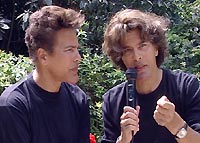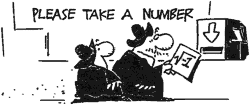|
home |
index |
units |
counting |
geometry |
algebra |
trigonometry & functions |
calculus
analysis | sets & logic | number theory | recreational | misc | nomenclature & history | physics |
Final Punch Lines |
Related Links (Outside this Site)Mathematicians, Physicists, Engineers, Programmers, etc. by David Shay.Bamdad's Math Comics by Bamdad Samii (Cal. State Northridge). mathNEWS by Jennifer Costello (University of Waterloo) | Fun with Math Math Jokes | Math in the Media (1999-08) | Engineering School Jokes The Frog and the Engineer | Chocolate Chip Cookies | Truth or Fiction Awarding the Wrong People? | Tom Swanson's Cartoon Page Worthless Word for the Day by Michael A. Fischer. | Johnny's Jokes A Guide to Effective Scientific Communication & other jokes, by Stewart Hector. Physical Theories as Women, by Simon Dedeo. The Crackpot Index, by John Baez. www.crank.net: Cranks, crackpots, kooks & loons ... |
 (2002-11-04) Why did the chicken cross the road? Is it really just to get to the other side? Scientific explanations:
The fittest chickens cross roads. [Darwin] Unscientific ones:
For fun. [Epicurus] Philosophical perspectives:
It was a historical inevitability. [Karl Marx]  Spinoff:
Q: Why did the chicken cross the
Möbius strip? (2002-07-01) Quotations Funny or gripping. Silly or wise. Provocative or inspirational.
Socrates
(469-399 BC), early moral philosopher.
Plato
(427-347 BC), legendary philosopher (founded the Academy
in 387 BC).
Archimedes of Syracuse
(287-212 BC), legendary engineer.
Roger Bacon
(1214-1294), medieval scientist.
William
of Ockham (1288-1348).
Occam's Razor is the rule of parsimony:
William Rowan Hamilton (1805-1865),
Irish mathematician.
Paul
Ehrlich (1854-1915;
Nobel 1908),
bacteriologist.
Bertrand Russell (1872-1970;
Nobel 1950),
mathematician and philosopher.
[Godfrey Harold]
G.H.
Hardy (1877-1947), quintessential mathematician.
Albert
Einstein (1879-1955;
Nobel 1921),
legendary physicist.
John
von Neumann (1903-1957), mathematical prodigy.
John
Wheeler (1911- ), foremost patriach of modern physics.
Paul
Erdös (1913-1996), legendary mathematician.
Richard
P. Feynman (1918-1988;
Nobel 1965),
cult figure of physics.
Steven
Weinberg (1933-;
Nobel 1979),
leading physicist and cosmologist.
Stephen Hawking
(1942- , FRS). Lucasian Professor of Mathematics.
Michel Audiard (1920-1985),
French playwright
known for hilarious dialogs. quoteworld | quotationspage | quoteland | sayings | science | brainyquote | last words | Andy's | etc. (2003-05-03) Famous Last Words Guesses from the best experts are just guesses...
Irving Fisher
(1867-1947), leading US economist [Yale University].
Albert
Einstein (1879-1955;
Nobel 1921),
legendary physicist.
Thomas John Watson, Sr.
(1874-1956), chairman of IBM. Top 10 Scientific Blunders | The Crystal Ball: from Here to Eternity | Famous Last Words (2002-11-06) Well-Documented Anecdotes General RelativityOn November 6, 1919, Arthur Eddington (1882-1944) announced the results of his eclipse expeditions on May 29, which had confirmed Einstein's prediction of the bending of light by gravity. The occasion was a joint meeting of the Royal Society and the Royal Astronomical Society. The chairman for the session was J.J. Thomson (1856-1940; Nobel 1906), who was then president of the Royal Society (he held the position from 1915 to 1920). In his concluding remarks, Thomson said that: "No one has yet succeeded in stating, in clear language, what the theory of Einstein really is." As the meeting was dispersing, this statement prompted the polish-born physicist Ludwig Silberstein (author of an early book on Relativity) to come up to Eddington: - Professor Eddington, you must be one of three persons in the world who understands general relativity... Don't be modest. The full story was told by Eddington, at a dinner of Trinity College during the Christmas recess of 1933, in the presence of his famous student Subrahmanyan Chandrasekhar (1910-1995; Nobel 1983). It appears in Chandrasekhar's 1987 book "Truth and Beauty", and/or in an earlier article of his, entitled "Einstein and general relativity: Historical perspectives". This is probably the origin of the popular myth that: "Only three people in the world understand Relativity." The 67th Mersenne NumberThe number 2n-1 (now called the nth Mersenne number) can only be prime if the exponent (n) is itself prime. This necessary condition is not sufficient : Although 11 is prime, the eleventh Mersenne number is 2047, which is not (it's the product of 23 and 89)... In 1644, Marin Mersenne (1588-1648) gave the first values of n for which the number obtained was thought to be prime (Mersenne primes may be used to form perfect numbers). This mysterious list started correctly with 2, 3, 5, 7, 13, 17, 19, 31... However, Mersenne's next entry was incorrect, as he omitted 61 which does belong (as first shown by I.M. Pervushin, in 1883) and included 67, which does not. The Mersenne number corresponding to n = 67 is huge: 147573952589676412927. This number was shown to be composite well before the computer era (by Edouard Lucas, around 1875) but it was not clear at the time if an explicit factorization of such a large number could ever be found. So it was thought in October 1903, when Frank Nelson Cole (1861-1926) walked up to the blackboard, at a meeting of the American Mathematical Society (AMS). The announced title of his presentation was "On the Factorization of Large Numbers". Cole silently calculated by hand the 67th power of 2, subtracted 1, and wrote the result (147573952589676412927) on one side of the blackboard. Then, he multiplied 761838257287 by 193707721 and obtained the same result... Cole did not utter a word and simply went back to his seat, under the first and only standing ovation ever recorded at an AMS meeting. There were no questions. Cole was a professor at the University of Columbia. He had worked every sunday for 3 years to find this factorization. Professor Cole served as AMS secretary for 25 years. Two prestigious prizes (in Algebra, and in Number Theory) have been founded in his honor. Anecdotes about famous scientists (2002-11-03) Parodies and Hoaxes Clever practical jokes help make the intellectual world a healthier place. The Mystical Properties of 137 - 1931In 1931, three physicists (including future Nobel laureate Hans Bethe) managed to publish the famous spoof article reproduced below [in an English translation taken from "A Random Walk in Science", a compilation by R.L. Weber, edited by E. Mendoza and published in 1973 by the Institute of Physics (London)].
This short article actually ridiculed the mystical kind of numerology
which was once advocated by Sir Arthur Eddington,
when our experimental knowledge of Sommerfeld's fine structure constant
(a) was consistent with the exact value 1/137
[the currently accepted value is
Spoofingly equating degrees of freedom and degrees of temperature
in the centigrade scale (which would officially be named after
Anders Celsius in 1949),
the authors offer a silly "explanation" for the fact that the absolute zero of temperature
(-273.15°C) happens to be numerically close to
The Great Carlos - 1988In 1988, the so-called channeling craze (which had began in earnest around 1972) was in full swing, spearheaded by actress Shirley MacLaine and many others. The professional magician James Randi (the Amazing Randi) was approached by Channel 9 from Australia with an offer to debunk the whole thing (hear an interview of James Randi, also posted by the Round Earth Society). Randi took up the challenge and taught his friend José Alvarez a few tricks to impersonate the channeler of a fictitious 35000-year old spirit dubbed "Carlos". As it turned out, "The Great Carlos" received a lot of media attention in Australia (culminating with a show at the Sydney opera house) and eventually developed a rather large following there... Surprisingly, many continued to believe in "Carlos" and his silly messages, even after the hoax was publicly revealed! The Sokal Hoax - 1996In 1996, the phycisist Alan Sokal published a paper with a rather pompous title:
Transgressing the Boundaries It was, in fact, a cleverly disguised [and hilarious] parody, which had only the appearance of serious scholarly work: In the very first paragraph, Sokal criticizes the "dogma" [sic] according to which "there exists an external world, whose properties are independent of any individual human being". The rest of the paper is similarly salted with nonsense. Yet, it suited so much what the editors of Social Text wanted to see that they did not even blink, and Sokal's article was duly published, next to other pieces of fashionably correct prose... The Bogdanov Affair - 2002This controversy is about the supposedley rigorous process which takes place before scientific doctorates are awarded. It's one thing to fool the editors of a cultural journal using scientific gibberish, like Sokal did. It would be another thing entirely if the same tactics could be successfull with a doctoral jury... Many people hastily talked about a "reverse Sokal hoax", when physicist Max Niedermaier first blew the whistle in an e-mail he sent to several friends around 2002-10-22. Niedermaier himself has since apologized and recognized that the Bogdanoff brothers "genuinely believe in what they are doing". The whole thing would probably have gone unnoticed if the Bogdanovs had not been television celebrities, but this does not make the issue go away...  The twin semioticians Igor and Grichka Bogdanoff were born in 1949, in a castle of Gascony (southwest France). They are gifted science-fiction writers who became famous in France as hosts of their own television show (Temps X) which premiered on April 21, 1979 (it aired prime-time on TF1 from 1980 to 1990). With the philosopher Jean Guitton (1901-1999), they coauthored a subsequent bestseller entitled "God and Science" (Dieu et la science, Grasset 1991, ISBN 2-246-42411-9). Doctorates in mathematical physics from the French Université de Bourgogne were recently awarded to Grichka (1999-06-26) and Igor (2002-07-08). Dr. John Baez and others (including Field medalist Alain Connes) have since reviewed both doctoral dissertations and at least four related journal articles published by the Bogdanovs: To summarize bluntly, the latest scientific jargon is clearly there, but actual scientific substance seems to be lacking... Or is it? The twins resumed their TV careers on October 3, 2002, weekly staging digital clones of themselves in 2-minute spots for public French television (France 2).
You have a point, Ark: Regardless of the scientific merits of their work, the Bogdanovs didn't deserve the public ridicule they were initially submitted to. Let's just state that a page about humor may include a few things that are not meant to be funny, including a possible example of an unethical use of derision.
Frauds & Hoaxes
|
Museum of Hoaxes
|
The
Age of the Universe is a Function of Time
(2002-05-26) Funny Units Our top picks of funny units... [See also the serious side.]
In the Troy system of units,
the millihelen is the amount of beauty required to launch one ship.
Its value in natural units [natural beauty] is about
0.001098612.
The microcentury is 52 minutes and 35.76 seconds and was introduced by Enrico Fermi as the "standard" duration of a lecture period. It's equal to exactly 3155.76 s, as an exact submultiple of the scientific Julian century, which is defined to be equal to 36525 days of 86400 (SI) seconds each. The attoparsec (apc) is the only official SI unit in this dubious bunch, it's equal to about an inch (or 1¼", more precisely, 3.08567758 cm)... Well, as they say, "Give some people an attoparsec and they'll take 16.09344 tera-ångströms." A nanoacre is exactly 4.0468564224 mm2. The microfortnight is about one second (more precisely, 1.2096 s). The furlong per fortnight is about 2 ft per hour (0.1663 mm/s). The millicochrane and microcochrane are submultiples of a unit of subspace distortion, named after Zefram Cochrane (2030-2117). If you think the above is pretty bad, check some of the entries here, or below:
(2002-05-27) Funny Prefixes There are no official metric prefixes above 1024 or below 10-24. What are some proposals to remedy that? The one "proposal" which is not funny is the subreptitious introduction, a few years ago, of 10 bogus prefixes (revo, tredo, syto, fito, ento, hepa, otta, nea, dea, una) which found their way next to legitimate ones in many serious summary tables floating around the Internet. There does not seem to be any way to get rid of those, except by encouraging whoever maintains a legitimate table to flag those prefixes as "bogus". Just removing them entirely is simply not good enough, as long as there are tables around which will look more "complete" by listing the bogus information (and thus "reproduce" faster). We took the initiative of starting the curative debunking by putting online a reference table that's hopefully "clearly better" than similar ones, in the hope that it would look authoritative enough to anyone researching the subject on the Internet... This debunking seems to be slowly catching on, as some tables are starting to appear which are clearly based on our own vetted table, while others [ 1 | 2 ] include a footnote with some link to this site. Either type of "bogus" warning serves as an erratum for all other similar tables a websurfer may be faced with. Spread the word... Now, back to the lighter side of the issue... Here are the "proposals" we gleaned (so far) for the next pair of metric prefixes:
The last entry above is part of a scheme apparently advocated by the Oxford clinical pharmacologist Jeff K. Aronson, who argued that the "pattern" of abbreviations Z and Y for the latest official SI prefixes should be extended through the alphabet, by making X, W, V and U the abbreviations of the next large prefixes (and using x, w, v and u for the next small ones). Since the letter T is already used for tera-, the scheme would only allow 4 more pairs of prefixes, but this should be more than enough for now... The "new" names could be "xenna", "weka", "vendeka", "udeka", for the larger prefixes, "xenno", "weko", "vendeko", "udeko", for the smaller ones. We don't know how serious Professor Aronson really was about this... Unfortunately, this is being propagated as a fait accompli, so the thing may have already turned into yet another annoying hoax, until the CGPM finally adopts something (anything!) to fill the void... "millikan-" (mkan) could be another natural name to propose for the 10-27 prefix (mkan = milli-kilo-atto-nano), which is so much needed just below yocto- (the current smallest official prefix). The mass of an electron would thus be expressed as equal to "about 0.91 mkang". That would only be fair to Robert A. Millikan (1868-1953), who was cursed with a name that makes it otherwise impossible to achieve the same kind of SI immortality as Pascal, Newton, Ampère, Tesla, Weber, or Alexander Gram Bell [sic]... Either that, or we have to call a kan the charge of 1000 electrons (so each single electron would carry a millikan of charge). For the record, this very silly idea of mine dates back to 1995, and I am almost ashamed to repeat it here... (2002-11-03) Anagrams Build your own anagrams at www.wordsmith.org.
From the anagram page of GG Wiz:
A few gems from www.anagrams.net:
(2002-10-24) MNEMONICS Mnemonics Neatly Eliminate Man's Only Nemesis: Insufficient Cerebral Storage... My Nasty Editor Might Occasionally Not Interpret Commas...
Please Excuse My Dear Aunt Sally.
Important! Very eXcellent Learning Can Demand Memorizing.
King Hector Doesn't (Usually) Drink Cold Milk.
Dairy Cows Make Milk Not Pink Fruit, Airhead!
Those Girls Can Flirt And Other Queer Things Can Do.
Pregnant Virgins Never Reveal the Truth
OIL RIG
Cary Grant eXpects Unanimous Votes In Movie Reviews.
My Very Educated Mother Just Showed Us Nine Planets.
Roy G. Biv (Richard Of York Gave Battle in Vain)
Oh Be A Fine Girl, Kiss Me! (Right Now Sweetheart!)
--Henry Norris Russell Numerical valuesCount the number of letters in each word to obtain each digit of the number. (A ten-letter word represents a zero digit.)
A short poem by Joseph Shipley (1960):
Famous French Poem:
[There are minor variants; this is the nicest we know!]
This gives p (Pi) to 126 decimals (127 digits in 127 words)... See also...
(2002-10-27) Acronyms Silly acronyms, or alternate interpretations for established ones. See also below some acronyms [supposedly] used in computerized conversations and/or Internet posts. The following ones do not fall into that category: ACRONYM: Abbreviated Coded Rendition Of Name Yielding Meaning. BAD: Broken As Designed. DAP: Parents Against Dyslexia [sic].
PCMCIA: People Can't Memorize Computer Industry Acronyms.
[Glenn Shaw] TLA: Three-Letter Acronym.
TTP: The TTP Project.
[Engineering classic, submitted by Tony
Dercola] |
|||||||||||||||||||||||||||||||||||||||||||||||||||||||||||||||||||||||||||||||||||||||||||||||||||||||||
Some Usenet Acronyms |
| ||||||||||||||||||||||||||||||||||||||||||||||||||||||||||||||||||||||||||||||||||||||||||||||||||||||||||||||||||||||||||

 I missed one? [Colonel Sanders]
I missed one? [Colonel Sanders]